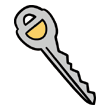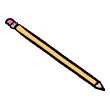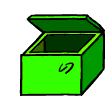|
|
- A- Ni' 'untsu kwthu lukli?
|
Where is the key? |
|
|
Here is the key. |
- A- Tth'ihwum ch 'i' m'i* 'amustham'sh.
|
Please come and give it to me. |
- B- Ni' 'untsu kwthu xul'tun?
|
Where is the pencil? |
|
|
Here is the pencil. |
- B- Tth'ihwum ch 'i' 'amust thu Lisa.
|
Please give it to Lisa. |
- A- Ni' 'untsu kwthu xthum?
|
Where is the box (or drum)? |
- B- 'E'ut 'i 'u tu'i tthu xthum.
|
Here is the box. |
- C- Tth'ihwum ch 'i' 'amust tthu John.
|
Please give it to John. |
|
Use the article tthu to refer to something that is in view.
| 'E'ut tthu lukli. |
"Here is the key (visible)." |
| 'E'ut tthu xul'tun. |
"Here is the pen (visible)." |
Use the article kwthu to refer to something that is not in view.
| Ni' 'untsu kwthu lukli? |
"Where is the key (out of sight)?" |
| Ni' 'untsu kwthu xul'tun? |
"Where is the pen (out of sight)?" |
Note: Some speakers use the feminine articles to refer to personal belongings of a female, for example thu s'itth'um "the dress", lhu poukws "her book", or thun' poukw "your book" (addressing a woman). These articles are introduced in Lesson 6.
Some speakers use the feminine articles with telu, "money": thu telu, lhu telu.
*Note: The Cowichan Tribes write mi. However, we will spell this word m'i throughout these lessons.


